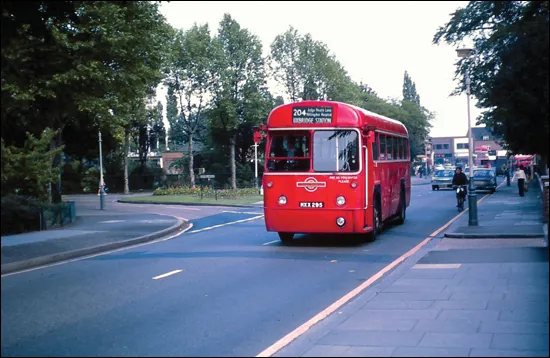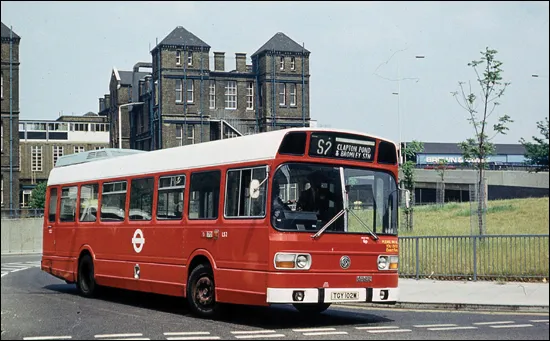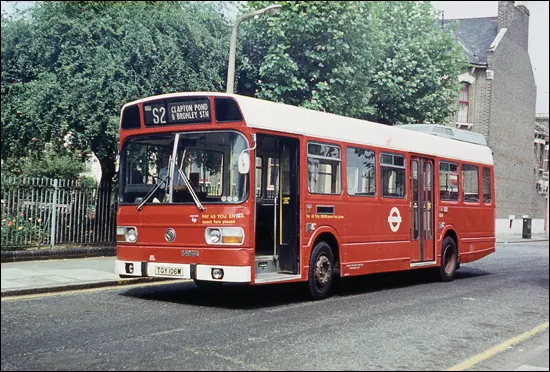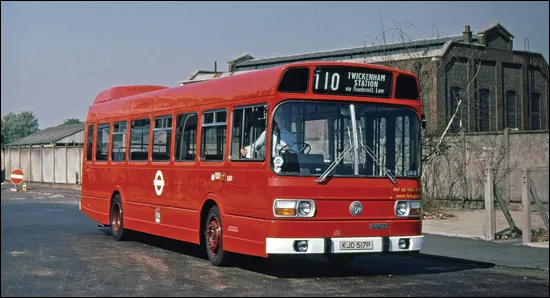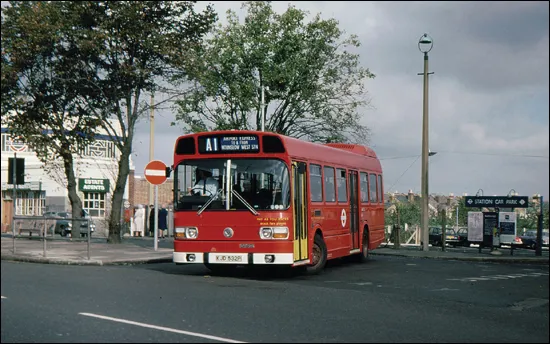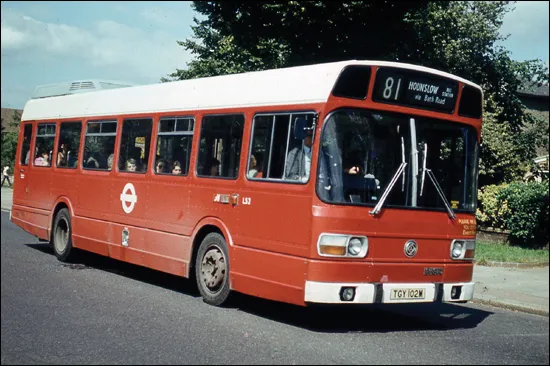![]()
CHAPTER ONE
ANTECEDENTS
London Transport was distinctly spoiled by the RF – rugged and almost indestructible, the 700-strong AEC Regal family was so good that it would prove difficult to replace. It was even adaptable to one-man operation (OMO), the latest hope that would tackle the twin hydras of rising costs and falling patronage suffered during the 1960s. But by the time the Reshaping Plan came along, the RFs were in middle age and even the Green Line modernisation several of them went through was only a stopgap; the new order would need specially-designed buses. Impressed by the undoubtedly successful Red Arrow route 500 introduced in 1966 with standee AEC Merlins, LT unfortunately made the fatal error of assuming that suburban passengers, as distinct from West End commuters, wouldn’t mind standing up during their carriage along curtailed routes anchored on interchange hubs. To make the standee-OMO concept pay for itself, it had to be extended as far fleetwide and as quickly as legislation could be written and rewritten to accommodate it. Routemaster deliveries came gently to their close and large orders for Merlins were placed.
Tough as nails, the RF racked up 28 years in London service, serving on both red and green routes and as buses and coaches. LT spun their service out as long as it could, knowing that any successor would have its work cut out. Here is Uxbridge’s RF 324 (MXX 295) on 16 June 1972 at Hayes; the 204 would subsequently spend most of a decade with LSs. John Laker
In accordance with the tenets of the Reshaping Plan that promised to alleviate its perennial staffing problems, London Transport ploughed ahead with single-deck OMO, but aside from the alienation of passengers by such extreme changes, the vehicles selected came up terribly short. There were two generations of AEC Swift-based flat-fare single-deckers, the latter forming the SM and SMS classes of 838 buses in total, and here in Chiswick on 11 August 1978 is SMS 804 (JGF 804K) out of Turnham Green. The E3 was converted to LS operation on 17 September 1978 and ran them until 1981. John Laker
The first wave of Reshaping bowed on 7 September 1968 and was immediately in trouble; the passengers didn’t appreciate the risk of embarrassment if the automatic fareboxes into which they now had to drop an exact fare failed to release the turnstiles, only to have to stand up thereafter, often with heavy shopping and children in tow. They already knew they didn’t like to change buses on one journey if they could help it, and nor did they appreciate being made to pay twice or more even if their previous through routes had become hopelessly snarled by traffic. The sheer unreliability of the MB and MBS classes didn’t help, and they were too long for London streets. After 665 were in service, LT switched to the shorter version, taking up the Swift name that properly applied to either length of chassis, and introduced the SMs and SMSs, 838 of which entered service up to early 1972. These were no improvement; the shorter body came with a correspondingly derated engine, which struggled to pull the heavy weight and indeed contributed to the buses’ deforming in the middle. Delicensing of failed buses reached epic proportions, exacerbated by a nationwide spares shortage and continuous spates of industrial action.
After the last SMSs were delivered, thoughts passed towards future single-deck purchases despite double-deckers, in the form of the DMS at this point, having come back into the ascendancy. The Leyland National was well on its way to supplanting the products of Leyland’s one-time competitors that it had progressively acquired, and its ease of construction, promising timely delivery, made it an obvious choice. At the same time, dissatisfaction with Leyland’s near-monopoly as it had effectively become since the falling away of orders for AEC buses, prompted hitherto unprecedented looks at foreign manufacturers. The Metro-Scania of Swedish chassis but carrying an MCW body had already seen service in London when VWD 451H spent part of 1970 on the 99 out of Plumstead, so in 1972 LT hedged its bets and ordered six of each. While LT waited, an example of the Leyland National (in LT red) was looked over at the start of 1973 but LT pronounced dissatisfaction with the gearbox and requested modifications, which were added to the demonstrator before it went away, and subsequently incorporated in the six LSs.
The Metro-Scanias, classified MS 1-6, seated B37D+29 and were the first to carry LT’s new livery incorporating a considerable proportion of white. They were delivered between May and July 1973 and entered service on the testbed route, Dalston’s S2, on 15 August. A little later came LS 1-6, London Transport’s first Leyland Nationals.
![]()
CHAPTER TWO
THE DALSTON EXPERIMENTALS
After a lifetime of painstakingly-designed bespoke-built buses constructed for interchangeability and longevity, followed by unhappy attempts to convince manufacturers to graft on familiar London Transport-spec components to existing provincial designs, the Leyland National was the opposite extreme, the factory-standard product par excellence; you got what you were given and you liked it. Thus did LT receive unfamiliar new examples of technology and equipment, for instance its first three-track number blinds at front and rear, though nothing was displayed on the side to the dismay of passengers, who lobbied LT unsuccessfully to have at least some destination information retrofitted. The numberplates were the stark new black-on-white versions experimented with as avant-garde but now made standard by the DVLC, and even the colour was off a Leyland paint swatch and thus not quite standard with existing LT buses, being a little darker. The only concession to LT’s identity and continuity at all was the seat moquette, the blue and green-based version current to DMSs and 1972 Underground stock. Further concessions to familiar practice were a LT-spec cab door and the new G2 transmission. To 10.3m length, capacity was B36D+27 and in LT’s engineering system were coded 1LS1.
Complete with the white roof and grey ventilation pod of the first six Nationals in London Transport, LS 2 (TGY 102M) is seen soon after entering service on Dalston’s S2. Haydn Davies
Dalston’s LS 6 (TGY 106M) shows off the nearside treatment of the first six LSs. This one has managed to stay out of Clapton Pond itself! Haydn Davies
Although the new LSs were destined to carry a version of the new livery phased in from 1973, with a significant proportion of white as the secondary colour, LT had to apply the white themselves; it covered the area above the windows. The roof pod was grey; LS 2 was delivered with a white roof pod but was amended prior to entry into service. LSs 1-6 had the registrations MYK 101-106L booked for them, but their late delivery caused these marks to be voided and they entered service licensed with TGY 101-106M.
Delivered in ones and twos (LS 1 in July, LS 2 in August, LSs 4 and 6 in September and LSs 3 and 5 in October), LSs 1-6 entered service on Dalston’s S2 on 19 November 1973, three months after their Metro-Scania counterparts. Although no comparable first-day dives into Clapton Pond were suffered, LS 3, at the same location on its own first day, struck in succession a car, a van and a motorbike! As the buses needed to go back and forth to Aldenham for attention, an element of MBS operation was retained on the S2, and indeed in May 1974 five Merlins were transferred into Dalston to offset teething troubles to both the LS and MS classes, though their fitment with LS blinds meant no route numbers could be displayed.
In spite of noise reduction insisted upon by LT, the LSs’ external noise was unmistakable, whining at idle rather than chug-chugging, combined with the harsh puff of air released to flick open its four-leaf doors (two identical sets of which folded to the sides in each doorway). From time to time the buses would exhale to themselves, earning from enthusiasts the sobriquet ‘dish’, which was rather kinder than the ‘Nasty’ nickname known everywhere else!
![]()
CHAPTER THREE
THE HOUNSLOW BATCH
Two years after the S2’s treatment to LSs, it was announced in October 1975 that London Transport had taken up the option on a batch of 51 Leyland Nationals ordered by the transport authority of Caracas, Venezuela but subsequently cancelled. That city would amass a total of 450 Nationals, becoming the largest export market ahead of Jamaica (125 examples) and Trinidad & Tobago (40). Export totals would prove disappointing for Leyland despite the model going on to rack up about 15,000 units built altogether. As in the UK, isolated operations operated their Nationals for close to thirty years.
Authorised by the GLC on 16 December 1975 and expected from April 1976, LSs 51-57 were intended not as a harbinger of future generations of single-deck buses but as an emergency plugging of the still severe spares and availability situation, and it was envisaged that they could just as easily be disposed of as could an equivalent number of Swifts once the problems had eased. To that end, the batch would be allocated en bloc to Hounslow, where LSs 1-6 would join them in due course; all would replace SMSs for transfer to the hardest-hit such operating garages. Total outlay came to £1.3m including tools, spares and a little structural work to Hounslow garage.
Broadly to the same spec as their predecessors, LSs 7-57 began arriving in May 1976 and training commenced at Hounslow; the first numbered of these was one of the buses on display at LT’s Gala Day at Syon Park on the 16th. Despite deliveries overrunning the August year-letter change, all retained their booked registration marks spanning KJD 507-557P. None were able to be fitted with automatic fare collection equipment, the buses operating as conventional OMO vehicles on Hounslow’s routes, and this time the livery was plain red with white filled roundels and fleetnumbers. The London Transport code was 2LS2.
LS 17 (KJD 517P) entered service at Hounslow in August 1976. It is seen at the 110’s Twickenham stand in September. Tony Wilson
On 13 June 1976 both the LS and MS complement of the S2 were stood down and the route was converted to SMS operation; both Nationals and Metro-Scanias were placed in store.
Entry of LSs 7-57 into service at Hounslow was phased over several weekends; on 15 August the 116 and 257 were converted, followed on the 22nd by routes 110 and 111 and on the 29th by the 203 and 203A, though in practice the suffixed variant was effectively withdrawn due to the inability of the new buses to display the ‘A’ letter; similar troubles at London Country had obliged the wholesale renumbering of several suffixed routes. On 19 September the A1 express received its new LSs, followed on the 26th by the 81, and finally, on 3 October, the 82 followed suit, completing the conversion. After a period in store, mostly at Mortlake, LSs 1-6 had their fareboxes replaced by a cab-mounted Almex E ticket machine and were transferred to Hounslow in October, by which time the whole batch of LS 7-57 was in service, but the Metro-Scanias, following cancellation of a plan to send them to Peckham for the P3, would linger for two years until sale in 1978; only MS 4 survives in preservation.
On 29 November LT announced its plans for vehicle purchase in the immediate future; as well as 450 double-deckers, 210 single-deckers were envisaged and all were intended to be Leyland Nationals. However, illustrating the increasing interference of politicians, the GLC asked LT for more information on 13 December, its transport committee recommending the immediate purchase of only fifty until LT could supply more information about vehicle reliability. In the interim, recertifications would be carried out on the best of the SMSs, buying them the time afforded by a four-year CoF. Whatever the future foretold for LSs, it would be marked by the withdrawal of the SMSs come what may, and withdrawals of long-term disused members of the SM family had already begun.
Long before the extension of the Piccadilly Line to Heathrow Airport, there was the A1, taking onward passengers from the line’s Hounslow West terminus of the time. It was converted from SMS to LS operation on 19 August 1976 and in October Hounslow’s LS 32 (KJD 532P) is seen about to leave Hounslow West station. Tony Wilson
In concert with the other five, LS 2 (TGY 102M) was transferred to Hounslow in October 1976, and not long after that is seen plying the 81. Haydn Davies

